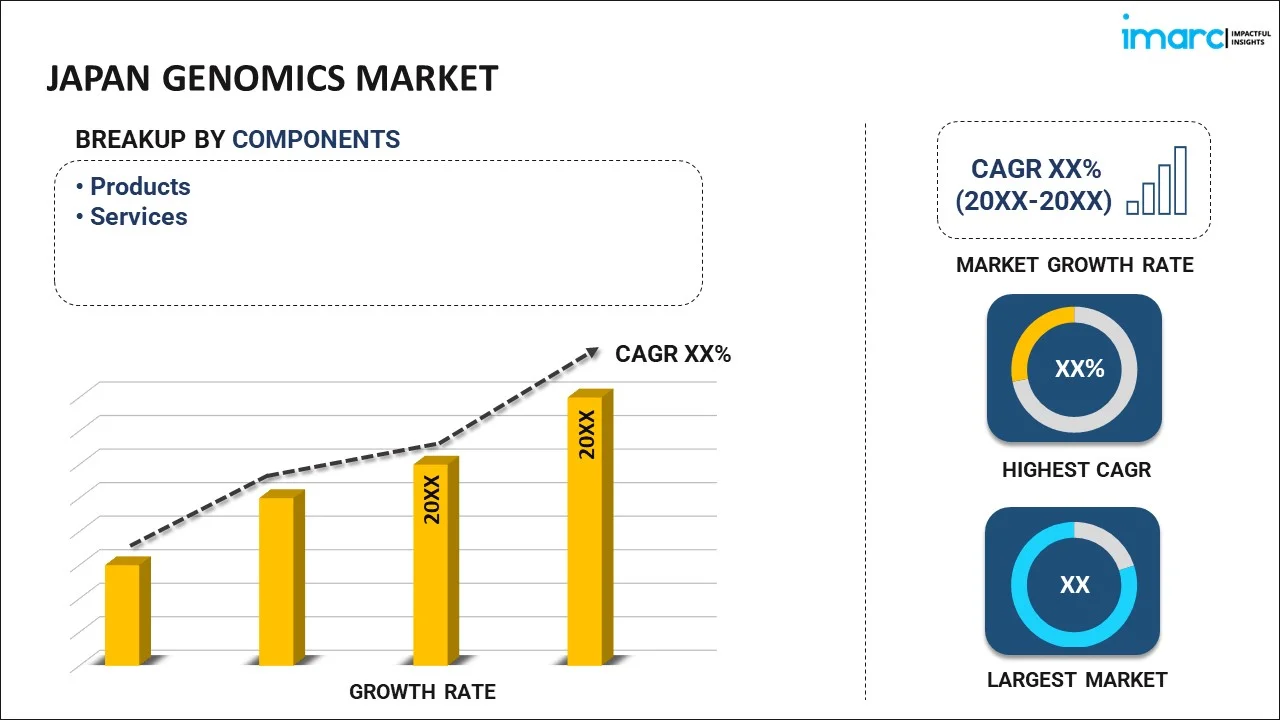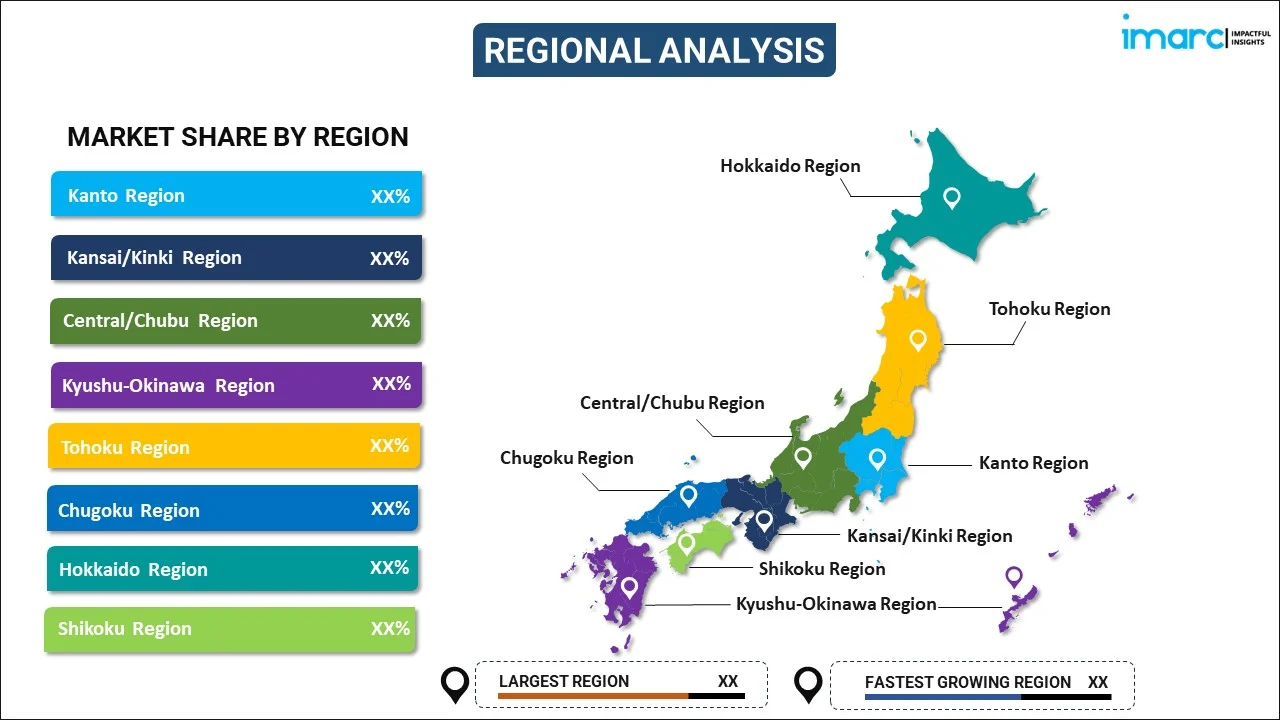
Japan Genomics Market Report by Component (Products, Services), Technology (Sequencing, Microarray, Polymerase Chain Reaction, Nucleic Acid Extraction and Purification, and Others), Application (Functional Genomics, Epigenomics, Biomarkers Discovery, Pathway Analysis, and Others), End User (Research Centers, Hospitals and Clinics, Pharmaceutical and Biotechnology Companies, and Others), and Region 2025-2033
Market Overview:
Japan genomics market size reached USD 2,271 Million in 2024. Looking forward, IMARC Group expects the market to reach USD 7,333 Million by 2033, exhibiting a growth rate (CAGR) of 13.9% during 2025-2033. The increasing incidences of genetic diseases and conditions, which has enhanced the demand for genetic testing and sequencing services, are primarily driving the market.
|
Report Attribute
|
Key Statistics
|
|---|---|
|
Base Year
|
2024 |
|
Forecast Years
|
2025-2033
|
|
Historical Years
|
2019-2024
|
| Market Size in 2024 | USD 2,271 Million |
| Market Forecast in 2033 | USD 7,333 Million |
| Market Growth Rate (2025-2033) | 13.9% |
Genomics refers to a branch of biology that focuses on studying the complete set of an organism's genes, known as its genome. It encompasses the analysis of an organism's DNA, including its sequence, structure, function, and variations. Genomics plays an essential role in understanding the genetic makeup of living organisms, from humans to plants and microbes. This field has far-reaching implications for various aspects of life sciences and healthcare. It enables researchers to unravel the genetic basis of diseases, identify potential drug targets, and develop personalized medicine approaches. Genomics also aids in the study of evolution by comparing genomes across species to trace common ancestry and evolutionary adaptations. Advancements in technology, such as high-throughput DNA sequencing, have revolutionized genomics, making it more accessible and affordable. As a result, genomics has led to breakthroughs in fields like genetics, medicine, agriculture, and conservation, offering insights into the fundamental building blocks of life and the potential to address complex biological questions and challenges.
Japan Genomics Market Trends:
The genomics market in Japan is being propelled forward by a multitude of compelling drivers. Firstly, the rapid advancements in sequencing technology have enabled the cost-effective analysis of an individual's entire genetic code, driving genomics into mainstream healthcare. Furthermore, the increasing prevalence of genetic diseases and the demand for personalized medicine have fostered a growing awareness of the potential benefits of genomics, thus boosting market growth. In addition to this, government initiatives and research funding in Japan have played a pivotal role in expanding the genomics market. Collaborative efforts between public and private sectors have resulted in extensive genome mapping projects and the sharing of genomic data, facilitating research and innovation. Concurrently, the rising adoption of genomics in agriculture, with applications like precision breeding and crop improvement, has opened up a substantial market opportunity. Moreover, the ever-evolving landscape of AI and data analytics has expedited the interpretation of complex genomic data, making it more accessible and actionable. These technologies have revolutionized drug discovery and development, further energizing the genomics market in Japan.
Japan Genomics Market Segmentation:
IMARC Group provides an analysis of the key trends in each segment of the market, along with forecasts at the country level for 2025-2033. Our report has categorized the market based on component, technology, application, and end user.
Component Insights:

- Products
- Instruments and Software
- Consumables and Reagents
- Services
- Core Genomics Services
- NGS-Based Services
- Biomarker Translation Services
- Computational Services
- Others
The report has provided a detailed breakup and analysis of the market based on the component. This includes products (instruments and software and consumables and reagents) and services (core genomics services, NGS-based services, biomarker translation services, computational services, and others).
Technology Insights:
- Sequencing
- Microarray
- Polymerase Chain Reaction
- Nucleic Acid Extraction and Purification
- Others
A detailed breakup and analysis of the market based on the technology have also been provided in the report. This includes sequencing, microarray, polymerase chain reaction, nucleic acid extraction and purification, and others.
Application Insights:
- Functional Genomics
- Epigenomics
- Biomarkers Discovery
- Pathway Analysis
- Others
The report has provided a detailed breakup and analysis of the market based on the application. This includes functional genomics, epigenomics, biomarkers discovery, pathway analysis, and others.
End User Insights:
- Research Centers
- Hospitals and Clinics
- Pharmaceutical and Biotechnology Companies
- Others
A detailed breakup and analysis of the market based on the end user have also been provided in the report. This includes research centers, hospitals and clinics, pharmaceutical and biotechnology companies, and others.
Regional Insights:

- Kanto Region
- Kansai/Kinki Region
- Central/ Chubu Region
- Kyushu-Okinawa Region
- Tohoku Region
- Chugoku Region
- Hokkaido Region
- Shikoku Region
The report has also provided a comprehensive analysis of all the major regional markets, which include Kanto Region, Kansai/Kinki Region, Central/ Chubu Region, Kyushu-Okinawa Region, Tohoku Region, Chugoku Region, Hokkaido Region, and Shikoku Region.
Competitive Landscape:
The market research report has also provided a comprehensive analysis of the competitive landscape in the market. Competitive analysis such as market structure, key player positioning, top winning strategies, competitive dashboard, and company evaluation quadrant has been covered in the report. Also, detailed profiles of all major companies have been provided.
Japan Genomics Market Report Coverage:
| Report Features | Details |
|---|---|
| Base Year of the Analysis | 2024 |
| Historical Period | 2019-2024 |
| Forecast Period | 2025-2033 |
| Units | Million USD |
| Scope of the Report | Exploration of Historical and Forecast Trends, Industry Catalysts and Challenges, Segment-Wise Historical and Predictive Market Assessment:
|
| Components Covered |
|
| Technologies Covered | Sequencing, Microarray, Polymerase Chain Reaction, Nucleic Acid Extraction and Purification, Others |
| Applications Covered | Functional Genomics, Epigenomics, Biomarkers Discovery, Pathway Analysis, Others |
| End Users Covered | Research Centers, Hospitals and Clinics, Pharmaceutical and Biotechnology Companies, Others |
| Regions Covered | Kanto Region, Kansai/Kinki Region, Central/ Chubu Region, Kyushu-Okinawa Region, Tohoku Region, Chugoku Region, Hokkaido Region, Shikoku Region |
| Customization Scope | 10% Free Customization |
| Post-Sale Analyst Support | 10-12 Weeks |
| Delivery Format | PDF and Excel through Email (We can also provide the editable version of the report in PPT/Word format on special request) |
Key Questions Answered in This Report:
- How has the Japan genomics market performed so far and how will it perform in the coming years?
- What has been the impact of COVID-19 on the Japan genomics market?
- What is the breakup of the Japan genomics market on the basis of component?
- What is the breakup of the Japan genomics market on the basis of technology?
- What is the breakup of the Japan genomics market on the basis of application?
- What is the breakup of the Japan genomics market on the basis of end user?
- What are the various stages in the value chain of the Japan genomics market?
- What are the key driving factors and challenges in the Japan genomics?
- What is the structure of the Japan genomics market and who are the key players?
- What is the degree of competition in the Japan genomics market?
Key Benefits for Stakeholders:
- IMARC’s industry report offers a comprehensive quantitative analysis of various market segments, historical and current market trends, market forecasts, and dynamics of the Japan genomics market from 2019-2033.
- The research report provides the latest information on the market drivers, challenges, and opportunities in the Japan genomics market.
- Porter's five forces analysis assist stakeholders in assessing the impact of new entrants, competitive rivalry, supplier power, buyer power, and the threat of substitution. It helps stakeholders to analyze the level of competition within the Japan genomics industry and its attractiveness.
- Competitive landscape allows stakeholders to understand their competitive environment and provides an insight into the current positions of key players in the market.
Need more help?
- Speak to our experienced analysts for insights on the current market scenarios.
- Include additional segments and countries to customize the report as per your requirement.
- Gain an unparalleled competitive advantage in your domain by understanding how to utilize the report and positively impacting your operations and revenue.
- For further assistance, please connect with our analysts.
 Inquire Before Buying
Inquire Before Buying
 Speak to an Analyst
Speak to an Analyst
 Request Brochure
Request Brochure
 Request Customization
Request Customization




.webp)




.webp)












